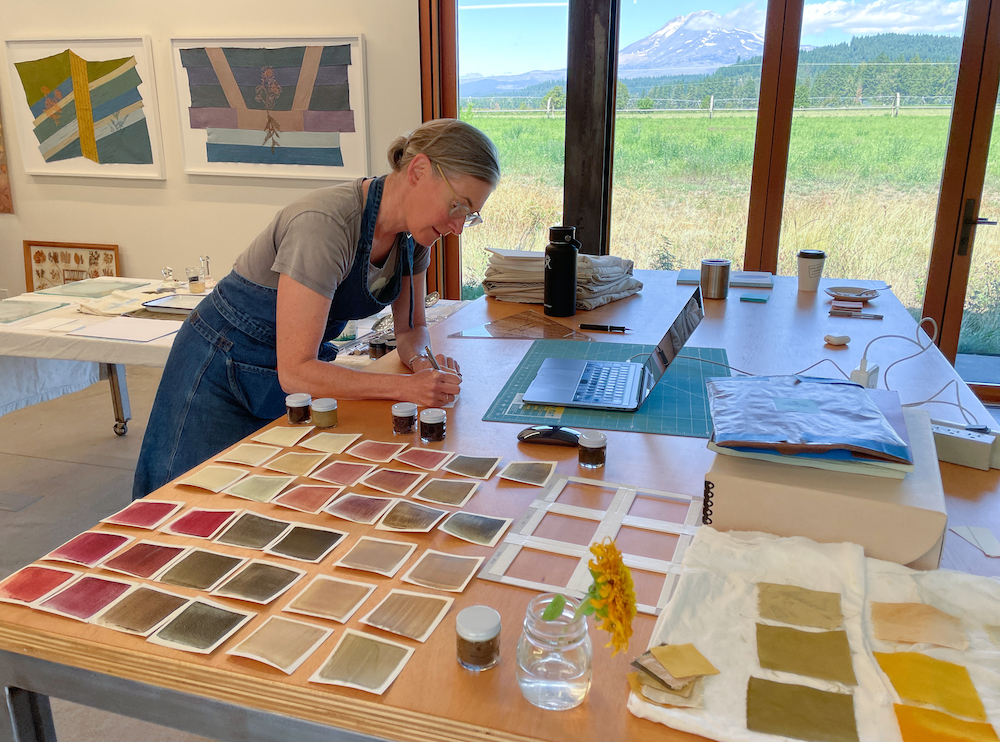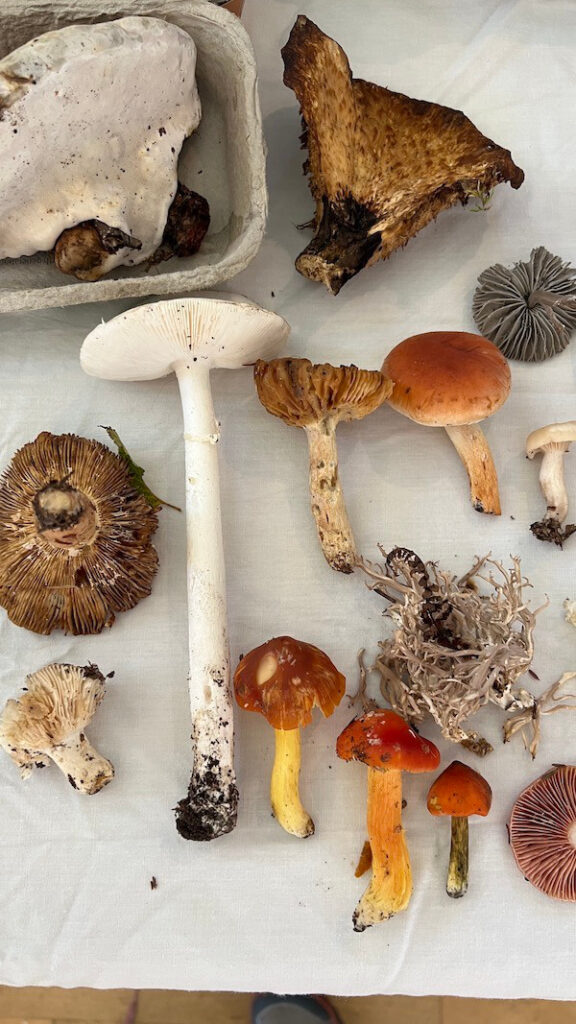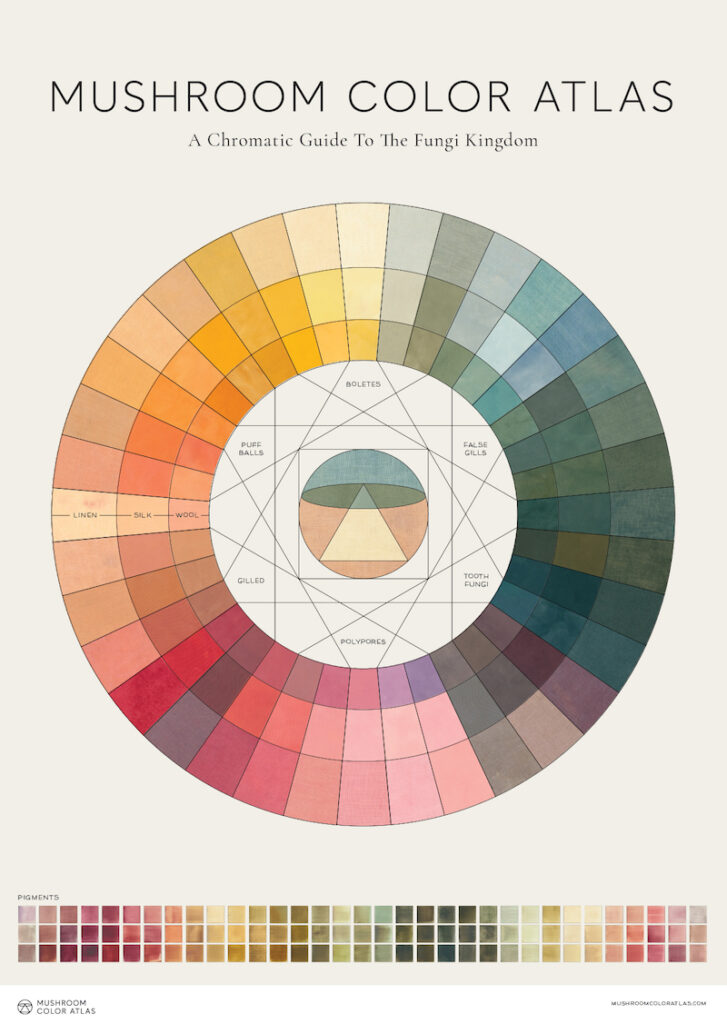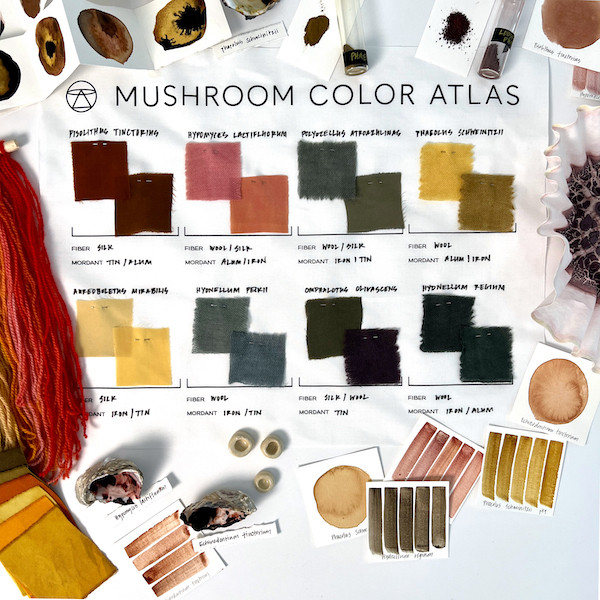
For this week’s Sunday Visit we caught up with Julie Beeler of the Mushroom Color Atlas. Julie is a designer, artist, educator and Oregonian who grew up with a deep love for and curiosity about the natural world. Julie says she experiments with the unpredictability of plants and fungi by growing and harvesting, observing and foraging, as well as tethering herself to nature’s seasons.
You might know remember Julie from her FEEDBACK FRIDAY presentation or her Mushroom Color Atlas poster and dye marks we sell. You might also just know here from taking one of her incredible classes. She has a pretty dedicated following!
We wanted to know more about Julie so we got her to sit down and answer some questions. Here’s what she had to say…
Who/what was your biggest inspiration that got you engaged with mushroom foraging and dyeing?
Ever since I was young I have been curious about mushrooms. I grew up going to the forests of Mt. St. Helens (until she erupted!) where I would marvel at all the interesting mushrooms. After college I met friends who were foragers and active in the Bay Area Mycological Society. I loved being invited to dinner after one of their forages and tasting the delectable wild mushrooms. I always wanted to learn how to identify mushrooms and thought I would find the time to delve into the fungi kingdom but alas life took off and it wasn’t until a few decades later I finally had some time to pursue my interest. I joined the Oregon Mycological Society right at the time I was trying to pivot my work with fiber and textiles. I knew a bit about natural dyes but thought to myself ‘I wonder if mushrooms make color?’ I did a quick Google search and came up with Miriam Rice’s book Mushrooms for Dyes, Paper, Pigments & Myco-Stix. It had just been reprinted so I immediately got a copy and down the rabbit hole I went.

You call yourself an alchemist. The Oxford Language defines this as “a person who transforms or creates something through a seemingly magical process.” Is what you do magic?
I wish! Sometimes it sure does feel like magic. Brewing up a batch of mushroom dyes or lakes can take on other worldly experiences (especially scents) where you kind of feel like some witchy alchemist concocting a potion to see what will come of it. The transformation is often very curious because there is still so much to learn, discover, study and document about the fungi kingdom, especially in regards to the chemistry and pigment compounds of different mushroom species. For example, most leading mycologists in the Pacific Northwest thought there were around 13 Cortinarius dermocybe species of dye mushrooms. Recent DNA research reveals up to 41 different species but how to visually identify them is unknown and something we are working towards advancing by collecting specimens. And, there are up to 14 different color pigment compounds within a Cortinarius dermocybe, each of which impacts the color, but we only really know and understand about 4-5 of them. It is very exciting to experiment, test and try to unlock the magical mysteries of mushrooms and coax color from them.

The Mushroom Color Atlas introduces people to the kaleidoscopic fungi kingdom and our connection to it. How long did it take you to create all the colors for it?
The back story is we had been through the thick of the pandemic, although it was far from over, and we were starting a new calendar year. It was January 2021 and I was thinking through my intentions for the upcoming year, reflecting on what I value most and how I wanted to make the most of my time in the year to come. For almost a decade I had been spending a lot of time with my fungi friends, doing different experiments and tests on how to extract different colorants and pigments, creating a series of artworks in my studio, teaching educational workshops and making mushroom color charts.
At the same time I had just retired from a career teaching in higher education so I was thinking about ways to fill that gap. I conceived of the Mushroom Color Atlas as an opportunity to provide an online educational resource about how to work with and use mushrooms for color. It was the perfect combination of bringing together my love of science, art and education as well as integrating elements of my former professional career of creating interpretive, interactive media apps, websites and installations.
I started the project in March of 2021 and it launched in October of that year. Making the original 525 colors that launched the project took about 2 weeks of dyeing, laking and painting. Since then I have added 300 more colors and I have an efficient process now. It takes 3 days to make a new series of 15 colors for each mushroom.
Talk about how you’ve learned about connections and networks through your work in the fungi kingdom. What seems the most hopeful from the fungi kingdom that can be transferred to our everyday life?
The mighty, often overlooked, fungi kingdom is all powerful! Almost every aspect of it is hopeful to me, except of course, the deadly toxic funguses and mushrooms. I believe the myriad of connections and networks created by the fungi kingdom is one of the most critical components that allows us humans to live on this planet. The fungi kingdom provides us with so many things ranging from medicinal properties, mycoremediation actions, synching carbon, composing and decomposing plant matter, aiding in the health of our forests, creating nutrient rich soil for growing food, fermenting capabilities, making alternative building materials, and providing us with beneficial, natural colorants and pigments.
The list can continue on and on so it is easy to see that we interact with the fungi in very beneficial ways in our everyday life, everyday!

I love this quote from Merlin Sheldrake about fungi from his book Entangled Life: “We are unthinking without them, yet seldom do we think about them. The cost of our neglect has never been more apparent. It is an attitude we can’t afford to sustain.”
To me it is this change in attitude that each and everyone of us needs to enact to realize all the hopefulness the fungi kingdom holds for us.
